 |
市場調查報告書
商品編碼
1420453
物聯網商業化及商業模式介紹:2024IoT Commercialization & Business Model Adoption Report 2024 |
||||||
本報告從六個主要部分分析了智慧互聯物聯網產品的商業化過程,重點介紹了成功的特徵和模式、常見陷阱和案例研究。 本報告中包含的資訊是基於 2023 年第三季對 100 家智慧互聯產品 OEM 進行的廣泛調查。
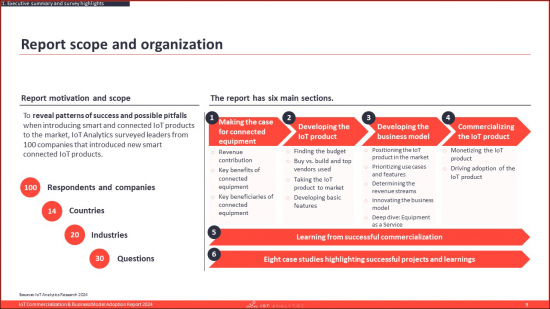
個案研究強調成功的專案和獲得的經驗教訓
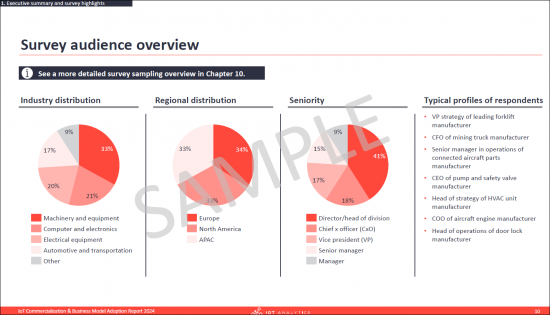

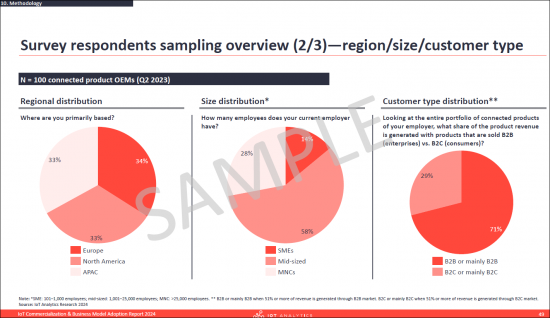
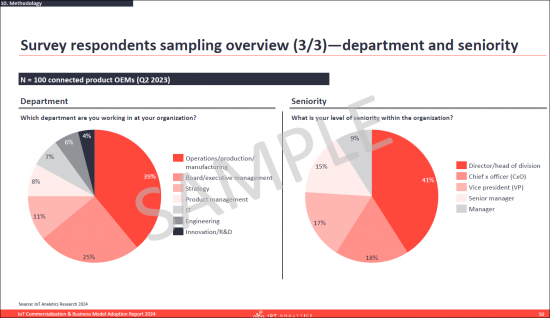
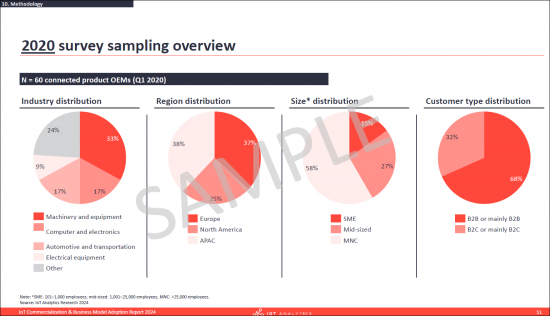
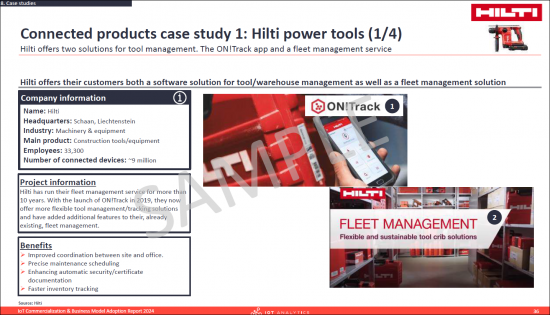
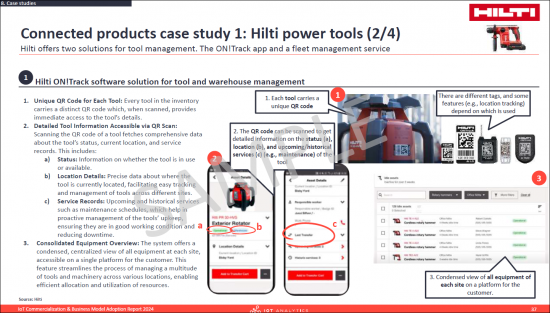
上市公司
|
|
目錄
第 1 章執行摘要/研究亮點
第 2 章簡介
第 3 章互連設備:支援案例
- 互聯產品對 OEM 收入的貢獻 (1/3) - 整體/區域
- 互聯產品對 OEM 收入的貢獻 (2/3) - 產業
- 互聯產品對 OEM 收入的貢獻 (3/3) 規模/顧客類型
- 物聯網產品的價值 (1/5) - 總體
- 物聯網產品的價值 (2/5) - 範例:從客戶那裡獲取見解
- 物聯網產品的價值 (3/5) - 按行業
- 物聯網產品的價值 (4/5) - 按地區、公司規模和客戶類型劃分
- 物聯網產品的價值 (5/5) - 按部門和資歷劃分
- 物聯網產品如何增強業務運作 (1/7) - 概述
- 物聯網產品如何增強企業營運 (2/7) - 按細分市場
- 物聯網產品如何增強業務運作 (3/7):實體產品的產品設計/工程
- 物聯網產品如何增強企業營運 (4/7):軟體產品設計/工程
- 物聯網產品如何增強公司的營運 (5/7):現場服務營運與製造。 過程
- 物聯網產品如何增強業務運作 (6/7):售後服務與客戶支持
- 物聯網產品如何增強業務運作 (7/7):銷售軟體/服務的銷售/行銷流程
- 範例:原始設備製造商 (OEM) 連接設備的三大好處
- 將物聯網產品使用資料整合到業務系統中 (1/2) - 概述
- 將物聯網產品使用資料整合到業務系統中 (2/2) 範例
第四章物聯網產品開發
- 智慧連網產品的預算 (1/3) - 整體成本
- 智慧連網產品的預算 (2/3) - 按組件
- 智慧連網產品的預算 (3/3) - 按組件/細分市場
- 智慧型互聯產品組件的預算分配
- 每個技術堆疊層的採購來源
- 受訪者使用的頂級物聯網供應商 (1/3) - 概述
- 受訪者使用的頂級物聯網供應商 (2/3) - 按技術堆疊
- 提到的開源工具/供應商
- 上市時間 (1/5) - 概述
- 上市時間 (2/5) - 按行業和地區
- 上市時間 (3/5) - 按發布年份、商業模式和公司規模
- 上市時間 (4/5) - 3 年比較
- 上市時間 (5/5) - 結果解讀
- 基本功能開發 - 概述
- 提供自助服務選項
- 提供使用資訊中心 (1/2)
- 無線 (OTA) 更新 (1/2)
- 無線 (OTA) 更新 (2/2) - 範例
第 5 章商業模式開發
- 新產品與現有產品的比較 (1/2) - 概述
- 新產品和現有產品 (2/2) - 按行業和地區
- 互聯產品功能的價值 (1/3) - 概述
- 互聯產品功能的價值 (2/3) - 詳細視圖
- 互聯產品功能的價值 (3/3) - 按細分市場
- 金屬加工機械連接產品
- 遠端服務/遠端控制:Grupo Cimbali
- 狀態監測:通快
- 營運儀表板:König & Bauer
- 營運儀表板:利勃海爾 (1/3):概述
- 操作儀表板:利勃海爾 (2/3):機器資訊
- 操作儀表板:利勃海爾 (3/3):報告訊息
- 能源監測:利勃海爾
- 監控客戶使用情況 (1/2):概述
- 監控顧客使用情況 (2/2):很好的例子
- 每個產品部分的收入貢獻 (1/2) - 幾年
- 每個產品部分的獲利貢獻 (2/2) - 按細分市場
- 商業模式創新 (1/3) - 概述
- 商業模式創新 (2/3) - 詳細概述
- 商業模式創新 (3/3) - 產業視角
- 其他商業模式見解 - 概述
- 提供軟體附加元件並從中獲利 - 例如 UNOX
- 向客戶租賃設備 - 例如利樂
- 提供具體的績效保證 - 例:江森自控
- EaaS OEM 採用狀況 (1/2) - 概述
- EaaS OEM 採用狀況 (2/2) - 按細分市場
- 企業實施EaaS的四個典型例子
- 客戶實施 EaaS
- 客戶為何採用 EaaS
- 客戶不願意引入 EaaS 的原因
- 確保成功轉向 EaaS 所需採取的行動
- 受訪者對成功轉向 EaaS 的其他見解
- 範例:擁有明確的價值主張
- 遷移到 EaaS 時的常見錯誤
- 遷移到支援 EaaS 的見解時的常見錯誤
第六章物聯網產品商業化
- 獲利與額外保證 (1/2) - 概述
- 創造收入與額外保證 (2/2) - 按細分市場
- 透過各種解決方案元素獲利 (1/3) - 今天
- 各種解決方案元素的貨幣化 (2/3) - 2 年內
- 透過各種解決方案元素獲利 (3/3) - 預期變化
- 概述:資料所有權與隱私
- 範例:影響互聯產品的隱私和安全法範例
- 推動客戶採用的因素
- 客戶實施問題/障礙 (1/2) - 概述
- 客戶實施問題/障礙 (2/2) - 自 2020 年以來的變化
第 7 章成功商業化的經驗教訓
- 成功 OEM 的五個特徵
- 成功物聯網商業化的識別
- 成功的 OEM:透過免費增值模式專注於軟體插件
- 成功的 OEM:幫助客戶優化工作流程
- 範例:通快工作流程最佳化
- 成功的原始設備製造商:優先了解客戶採用服務的障礙
- 成功的 OEM:將 IoT 資料整合到 CRM 和 ERP 系統中
- 成功的 OEM:有效利用 IoT 數據來推動銷售和行銷
第 8 章個案研究
- 連網產品案例研究 1:Hilti power tools
- 互聯產品案例研究 2:John Deere
- 連網產品案例研究 3:Schindler elevators
- 互聯產品案例研究 4:BMW cars
- 連網產品案例研究 5:UNOX ovens
- 設備即服務案例研究 1:Heller
- 設備即服務案例研究 2:Carrier
- 設備即服務案例研究 3:Mitsubishi
第 9 章附錄
第十章研究方法
第 11 章關於 IoT 分析
206-page report that analyzes how companies commercialize smart connected IoT products, including success characteristics and patterns, possible pitfalls, case studies, and more.
About the report
The “IoT Commercialization & Business Model Adoption Report 2024” is part of IoT Analytics' ongoing coverage of Industrial IoT and Industry 4.0. The information presented in this report is based on an extensive survey, conducted in Q3 2023, of 100 OEMs of smart, connected products. The purpose of the report is to inform other market participants, most notably other OEMs that start developing their own connected IoT product and their vendors, of the process for creating such products, as well as the benefits they provide. Survey participants were selected randomly, and their knowledge was verified independently. To ensure complete objectivity, IoT Analytics did not alter or supplement any survey results and did not accept participants that were suggested by third parties. The IoT Analytics team added a number of examples to make some of the survey results more "real" for the reader (e.g., pricing examples and examples of specific connected product features introduced by some OEMs).

This publication analyses the process of commercializing smart connected IoT products along 6 main sections:
1. Making the case for connected equipment
- Revenue contribution
- Key benefits of connected equipment
- Key beneficiaries of connected equipment
2. Developing the IoT product
- Finding the budget
- Buy vs. build and top vendors used
- Taking the IoT product to market
- Developing basic features
3. Developing the business model
- Positioning the IoT product in the market
- Prioritizing the use cases and features
- Determining the revenue streams
- Innovating the business model
- Deep dive: Equipment as a Service
4. Commercializing the IoT product
- Monetizing the IoT product
- Driving adoption of the IoT product
5. Learning from successful commercialization
6. Case studies highlighting successful projects and learnings
SAMPLE VIEW







Questions answered:
- How much are connected products contributing to OEM revenue, and how is this expected to change in the future?
- How are OEMs sourcing their tech stack?
- Which vendors are being used most often for each part of the tech stack?
- How valuable have the connected products been for the organization, and which company activities are they improving upon?
- What is the necessary budget for a company to create smart, connected products from scratch?
- How are OEMs innovating their business model?
- What are the biggest factors for driving customer adoption of connected products, and what are the most important concerns/roadblocks?
- How are OEMs monetizing their solutions?
- What is the state of Equipment as a Service (EaaS) , including adoption, necessary actions to be successful when pivoting to the model, and common pitfalls to avoid?
- Which business systems are integrated with the IoT product usage data?
- What extra features are OEMs offering to their customers on top of their connected products?
- What are the six main factors that differentiate companies with more successful IoT commercializations?
- What are some connected product and EaaS case studies?
Companies mentioned:
A selection of companies mentioned in the report.
|
|
Table of Contents
1. Executive summary and survey highlights
- Report scope and organization
- Who participated in this research (selection)?
- Survey audience overview
- This report is an update of the "IoT Commercialization & Business Model Adoption Report 2020"
- Executive Summary
- Highlight: 6 key insights from the analysis performed in the report
- Highlight: 5 characteristics of successful OEMs
2. Introduction
- Starting point: OEMs can tap into nine potential sources of revenue
- Search terms related to new OEM business models are slowly but steadily trending upwards
- Conceptual approach-the more connected, the higher the value potential
- IoT enables OEMs to develop new competitive advantages
- Universal Robots-an OEM journey in six years
- Connected products drive an OEM's services business
- This report takes the reader through the journey of an OEM
3. Making the case for connected equipment
- Contribution of connected products to OEM revenue (1/3)-overall/regions)
- Contribution of connected products to OEM revenue (2/3)-industry
- Contribution of connected products to OEM revenue (3/3)-size/customer type
- Value of IoT products (1/5)-overall
- Value of IoT products (2/5)-example: getting insights from customers
- Value of IoT products (3/5)-by industry
- Value of IoT products (4/5)-by region, company size, and customer type
- Value of IoT products (5/5)-by department and seniority
- How IoT products enhance a company's operations (1/7)-overview
- How IoT products enhance a company's operations (2/7)-by segment
- How IoT products enhance a company's operations (3/7): product design/engineering of the physical product
- How IoT products enhance a company's operations (4/7): product design/engineering of software
- How IoT products enhance a company's operations (5/7): field service operations and mfg. processes
- How IoT products enhance a company's operations (6/7): after-sales services and customer support
- How IoT products enhance a company's operations (7/7): sales/marketing processes to sell SW/services
- Example: Three main benefits when OEMs connect their equipment
- Integrating IoT product usage data into business systems (1/2)-overview
- Integrating IoT product usage data into business systems (2/2)-example
4. Developing the IoT product
- Budgeting for smart, connected products (1/3)-overall cost
- Budgeting for smart, connected products (2/3)-by component
- Budgeting for smart, connected products (3/3)-by component/segment
- Budget distribution for the components of smart, connected products
- Procurement sources for each technology stack layer
- Top IoT vendors used by respondents (1/3)-overview
- Top IoT vendors used by respondents (2/3)-by tech stack (1/2)
- Top IoT vendors used by respondents (3/3)-by tech stack (2/2)
- Open-source tools/vendors mentioned
- Time to market (1/5)-overview
- Time to market (2/5)-by industry and region
- Time to market (3/5)-by launch year, business model, and company size
- Time to market (4/5)-three-year comparison
- Time to market (5/5)-our interpretation of the results
- Developing basic features-overview
- Providing self-service options
- Offering a usage dashboard (1/2)
- Over-the-air (OTA) updates (1/2)
- Over-the-air (OTA) updates (2/2)-example
5. Developing the business model
- New vs. existing product (1/2)-overview
- New vs. existing product (2/2)-by industry and region
- Value of connected product features (1/3)-overview
- Value of connected product features (2/3)-detailed view
- Value of connected product features (3/3)-by segment
- Connected products in metalworking machines
- Remote service / Remote control: Grupo Cimbali
- Condition monitoring: Trumpf
- Operational dashboard: König & Bauer
- Operational dashboard: Liebherr (1/3): Overview
- Operational dashboard: Liebherr (2/3): Machine info
- Operational dashboard: Liebherr (3/3): Report info
- Energy monitoring: Liebherr
- Monitoring customer usage (1/2): overview
- Monitoring customer usage (2/2): case in point
- Revenue contribution of each product part (1/2)-through the years
- Revenue contribution of each product part (2/2)-by segment
- Business model innovations (1/3)-overview
- Business model innovations (2/3)-detailed overview
- Business model innovations (3/3)-industry view
- Additional business model insights-overview
- Offering and monetizing software add-ons-example: UNOX
- Letting the customer lease the equipment-example: Tetra Pak
- Offering specific performance guarantees-example: Johnson Controls
- EaaS OEM adoption status (1/2)-overview
- EaaS OEM adoption status (2/2)-by segment
- Four prominent examples of companies that have introduced EaaS
- Customer adoption of EaaS
- Reasons why customers adopt EaaS
- Reasons why customers are reluctant to adopt EaaS
- Necessary actions to guarantee a successful pivot to EaaS
- Additional respondent insights for a successful pivot to EaaS
- Example: Having a clear value proposition
- Common mistakes when transitioning to EaaS
- Common mistakes when transitioning to EaaS-respondent insights
6. Commercializing the IoT product
- Monetization and additional guarantees (1/2)-overview
- Monetization and additional guarantees (2/2)-by segment
- Monetization of different solution elements (1/3)-today
- Monetization of different solution elements (2/3)-in two years
- Monetization of different solution elements (3/3)-expected change
- Overview-data ownership and privacy
- Example-privacy and security laws affecting connected products
- Factors that drive customer adoption (1/2)
- Factors that drive customer adoption (2/2)
- Customer adoption concerns/roadblocks (1/2)-overview
- Customer adoption concerns/roadblocks (2/2)-changes since 2020
7. Learning from successful commercialization
- Five characteristics of successful OEMs
- Identifying a successful IoT commercialization
- Successful OEMs focus on software add-ons with a freemium model
- Successful OEMs help their customers optimize the workflow
- Example: Trumpf workflow optimization
- Successful OEMs prioritize understanding customer hurdles in service adoption
- Successful OEMs integrate IoT data with CRM and ERP systems
- Successful OEMs effectively utilize IoT data to boost sales and marketing
8. Case studies
- Connected products case study 1: Hilti power tools
- Connected products case study 2: John Deere
- Connected products case study 3: Schindler elevators
- Connected products case study 4: BMW cars
- Connected products case study 5: UNOX ovens
- Equipment-as-a-Service case study 1: Heller
- Equipment-as-a-Service case study 2: Carrier
- Equipment-as-a-Service case study 3: Mitsubishi













